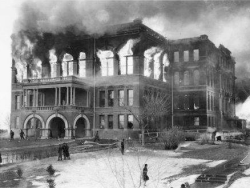Located at the crossroads of the Missouri River and northern transcontinental railroad, Bismarck – or, Edwinton as it was called during its first year – was destined for greatness when the Northern Pacific Railway founded the key city along its rail line in 1872. Early inhabitants sought to prosper on what was predicted to become a major metropolis. Some even hailed it as the “next Chicago.” While Bismarck never evolved into the likeness of Chicago, Bismarck’s colorful history is full of ingenious political maneuvers, innovative entrepreneurs, iconic historical characters, and exceptional prosperity.
The early days of Bismarck were turbulent and lawless, earning such reputations as the “Wickedest City in the West.” Troops, railroad workers, and gold prospectors filled the myriad of saloons, gambling houses, and brothels that lined the streets. Violence was so prominent, particularly along a stretch of Fourth Street, that such derogatory nicknames as “Murderer’s Gulch” and “Bloody Fourth” were once attached to the city. By some accounts, Bismarck averaged 1 murder per day at the time.
By the turn of the century, Bismarck had become established as an important economic, health, and government center. It was named capital in 1883 and gained the territory’s first hospital two years later.
The area was previously home to several dominant native tribes, most notably the Mandan, Hidatsa, Arikara, Sioux, and Chippewa.
La Vérendrye was one of the first outside explorers to the area, around 1738. Explorers Meriwether Lewis and William Clark camped the winter of 1804-1805 at a site roughly 40 miles to the north, along with their Lemhi Shoshone guide, Sakakawea.
Related Content
-
Pre-1871: Early History
Prior to formal organization by the United States Government, the region including and surrounding what is today... -
1871-1872: Establishment
Bismarck was founded as the town of Edwinton in 1872 by the Northern Pacific Railway at the... -
1873-1877: Railroad Arrives, New Name, Panic!
In the year following its founding, 1873 marked several key developments for the fledgling town… the first... -
1878-1883: Railroad Completes, Mandan Founded, Bismarck Assumes Capital
The years spanning 1878-1883 were quite possibly the most important in Bismarck’s history, cementing Bismarck’s future as... -
1884-1898: Industry, Statehood, and Fire
The next fifteen years reinvented Bismarck from an isolated frontier town into a dynamic modern city, fueled... -
1929-1944: Great Depression And The War
The stock market crashed in October 1929, causing widespread economic chaos across the United States. To make... -
1945-1959: Post-War Boom
Following World War II, Bismarck experienced significant growth and development. Its population nearly doubled from 1940 to... -
1960-1969: Demands Of A Growing City
By 1960, the city had over 27,000 citizens, and its aging public facilities were becoming inadequate. Even... -
1970-1979: Building Boom, Evolving Trends, & The Decay of Downtown
The 1970s were a time of major change for Bismarck. The decade would see the most development... -
1980-1999: Declining Growth
The 1980s opened with the recent completion of Gateway Mall and the expansion of the area’s largest... -
2000-Present: Reinventing Bismarck
By the new millennium, Bismarck had grown to more than 55,000 citizens. The tough retail trend that...



